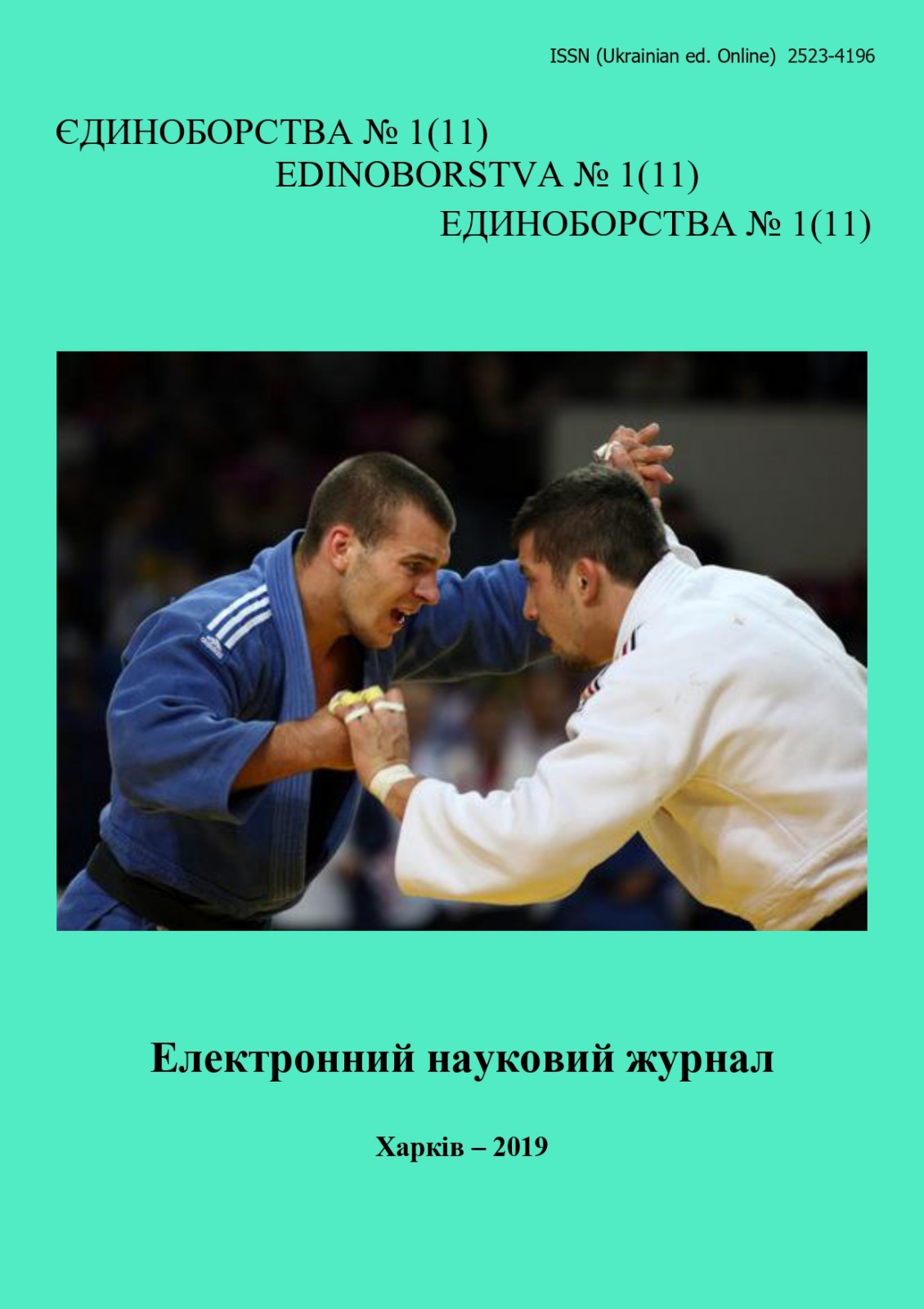Features and effectiveness of counterattacking actions in martial arts
Keywords:
competitive activity, counterattacking actions, efficiency, factors, level of preparednessAbstract
Purpose: to reveal the features and to justify the effectiveness of counterattacking actions in martial arts. Material and methods: analysis of scientific and methodological literature; pedagogical observations; analysis of competitive activities of qualified hand-to-hand fighting athletes (n=46); synthesis of results; mathematical processing of statistical and experimental data. Results: the main factors affecting the performance of competitive activities were highlighting. This are determining the level of preparedness of a specific athlete: a special physical, technical, tactical, theoretical, and his level of psychological stability and reliability. The features of the performance of counterattacking actions were reflected, and the effectiveness of their use was substantiated. The effectiveness of a series of punches is 72,1%. The effectiveness of combinations consisting of punches and kicks, cuttings and punches and / or kicks, as well as from strikes with the transition to the fight (making throws) is 78,9%. The efficiency ratio of the counterattacking action is 0,61. Of these: punches – 0,68, kicks – 0,43, combinations consisting of punches, kicks and throws – 0,55. Conclusions: The effectiveness of counterattacking actions have to be view through the prism of the athlete’s integrated level of preparedness. The effectiveness of attacking, defensive and counterattacking actions depends largely on the biomechanical structure of the movements, anthropometric data and other individual characteristics of athletes. During the execution of their own attacks, athletes are not always ready for counterattacking actions from opponents, often neglecting defense and, thus, enable them to carry out effective counterparts (counter blows and throws).
References
Архипов, О. А. (2014). Біомеханічний аналіз. НПУ ім. М.П. Драгоманова, Київ.
Бойченко, Н. В., & Гринь, Л. В. (2011). «Техніко-тактичні показники змагальної діяльності єдиноборців». Педагогіка, психологія та медико-біологічні проблеми фізичного виховання і спорту, №1, 10-13.
Лапутін, А. М., Носко, М. О., & Кашуба, В. О. (2001). Біомеханічні основи техніки фізичних вправ. Наук. світ, Київ.
Мунтян, В. С. (2013a). «Определение биомеханических показателей технических действий в единоборствах». Физическое воспитание студентов, № 4, 63–66.
Мунтян, В. С. (2013b). «Использование силы упругой деформации мышц при выполнении контратакующих ударов». Проблемы и перспективы развития спортивных игр и единоборств в высших учебных заведениях. ХДАФК, 245–247.
Мунтян, В. С. (2018). Fight-fitness: електронний навчально-методичний посібник. Нац. юрид. ун-т ім. Ярослава Мудрого, Харків.
Платонов, В. Н. (2015). Система подготовки спортсменов в олимпийском спорте. Общая теория и ее практические приложения. Олимп. лит., Киев.
Пономаренко, В. А. (2004). «Социально-психологическое содержание боевого стресса». Психол. журн., Т. 25, № 3, 98–102.
Попов, Г. И. (1991). «Взаимосвязь волновых процессов управления и исполнения в движениях многозвеньевых биомеханических систем». Биофизика, Т. 36 (2), 344–347.
El Ashker, S. (2012). «Technical performance effectiveness subsequent to complex motor skills training in young boxers». European Journal of Sport Science, 12(6), 475–484.
Iermakov, S., Podrigalo, L., Romanenko, V., Tropin, Y., Boychenko, N. & Rovnaya, O. (2016). «Psycho-physiological features of sportsmen in impact and throwing martial arts». Journal of Physical Education and Sport, Vol. 16(2), 433-441.
Korobeynikov, G. V., Latyshev, S. V., Latyshev, N. V., Korobeynikova, L. G., & Goraschenko, А. U. (2016). «General laws of competition duel and universal requirements to technical-tactic fitness of elite wrestlers». Physical education of students,;1:37–42.
Latyshev, S, Korobeynikov, G, & Korobeinikova, L. «Individualization of training in wrestlers». International Journal of Wrestling Science, 2014;4(2):28–33.
Rata, Gloria, Dobrescu, Tatiana, Rata, Bogdan, Constantin, Rata, Marinela, & Mares, Gabriel (2013). «Study Regarding the Order of Psychological Processes and the Importance of the Psychological Factors of High». Physical Education of Students, 22(8), 75-79.
Rahmat, Ali Jafari, Arsalan, Damirchi, Bahman, Mirzaei, & Hadi, Nobari (2016). «Anthropometrical profile and bio-motor abilities of young elite wrestlers». Physical Education of Students, 20(6), 63-69.













